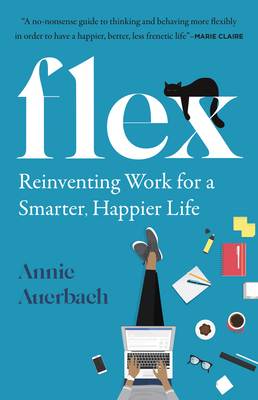
Flex
Reinventing Work for a Smarter, Happier Life
- اطلاعات
- نقد و بررسی
- دیدگاه کاربران
نقد و بررسی

December 1, 2020
COVID-19 has necessitated moving from traditional to flexible workplace models, making Auerbach's (cofounder of Starling, which specializes in brand strategy) work a timely one. She advocates for Flex (flexibility in the workplace and beyond) and the need to break away from traditional nine-to-five jobs. Her book focuses on how to implement and create the most effective models for flexible hours, particularly for women seeking to balance work and home life. The ingredients to successful implementation of Flex are many but include creativity in the workplace; lifestyle changes; avoiding distractions such as social media; budgeting times to take phone calls and write emails; balancing gender roles at home; avoiding burnout resulting from working long hours; and developing close friendships. The author also looks at various types of Flex models including job sharing, flex hours, phased retirement, location flex, on-off flex, flex banking, and compensation by annualized hours. Auerbach illustrates concepts very effectively through case studies and includes references for further reading. VERDICT Informative, practical, and timely, this title is recommended for working women and contains sound advice about the effective use of Flex in the workplace and at home.--Lucy Heckman, St. John's Univ. Lib., Queens Village, NY
Copyright 2020 Library Journal, LLC Used with permission.

December 14, 2020
Auerbach, the founder of a consultancy that “helps brands understand how society is changing,” suggests nine-to-five should be a thing of the past in this thin “manifesto for living and working on your terms.” The Covid-19 pandemic, Auerbach writes, forced companies to allow employees the flexibility to work from home and focus on their well-being—concerns Auerbach argues should have considered all along. Working and living flexibly, Auerbach writes, challenges “social norms like women bearing the brunt of the emotional load at home,” and allows employees to be happier and more creative. She offers tips to prevent work from carrying over into one’s home life, such as setting up “a clear out-of-office email with the times you will answer emails and the times you are out of contact,” and not checking emails within an hour of waking up. Unfortunately, she offers relatively few stories of companies who have made workplace flexibility central to their mission; instead, the book is heavy on large-type inspirational quotes and heavy design elements. Auerbach’s encouraging direction on “how to be human in a tech-driven world” will find willing ears among a workforce that’s reexamining how work and other responsibilities coexist. Still, those looking for a deep dive into a changing work culture will be left wanting more.

February 1, 2021
Blame it on COVID-19: the call for flexibility--once shunned in the workplace and elsewhere--has grown larger and louder in employer and employee practices. Yet inklings of the need to be agile have existed for quite some time. Owner of a UK trends agency, Auerbach delves into five areas where most of the world needs more malleability--mind, work, home, body, and future--and examines concepts, alternatives, anecdotes, and prescriptions. In "mind," for instance, creativity is the centerpiece, identified by the World Economic Forum as one of three must-have work skills (the other two being complex problem solving and critical thinking). By looking at the blocks to creativity, such as too much freedom, digital overload, and lack of empathy, solutions emerge: traveling, walking, reading, and other activities. In each chapter, a real-life flex story illustrates the concept, and a summary ensures good understanding of the concept's impact. It's a fair prediction that many work lives, and lives in general, will be far different post-pandemic.
COPYRIGHT(2021) Booklist, ALL RIGHTS RESERVED.




دیدگاه کاربران